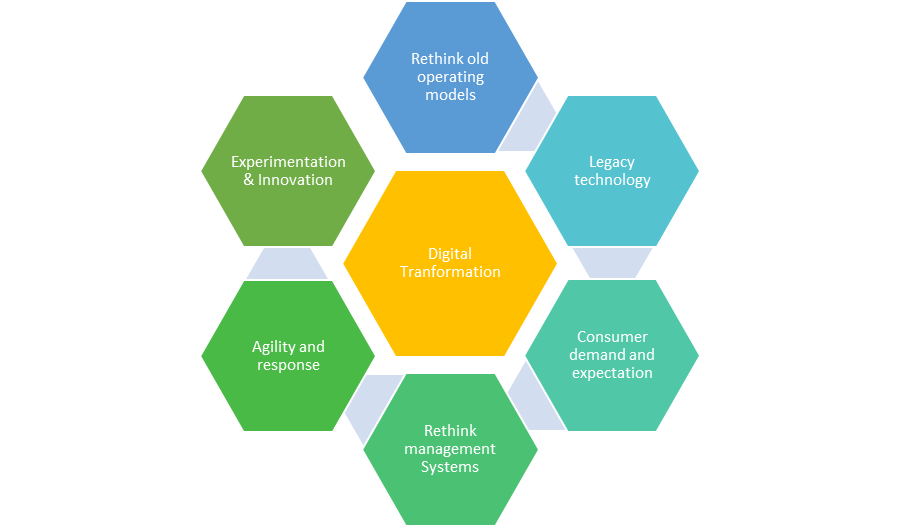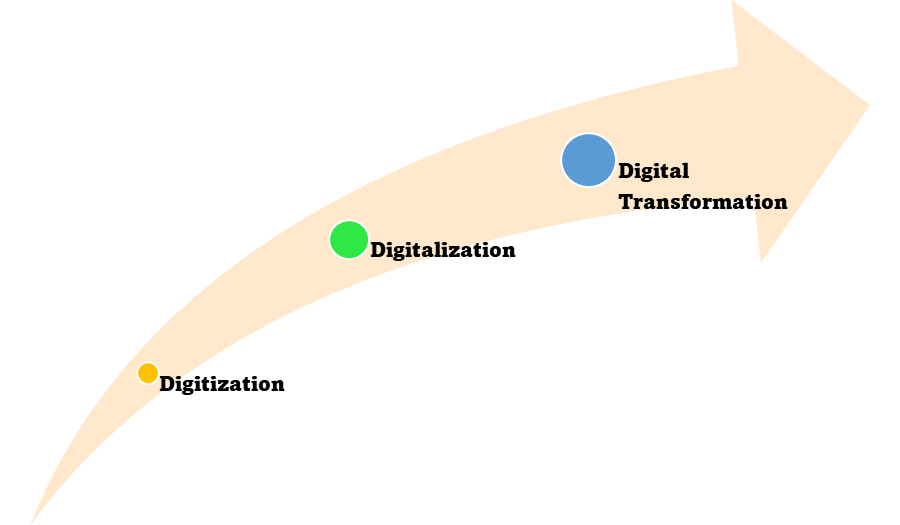All businesses, from large enterprises to small ones have one common goal - to turn a profitable operation. In the business world of today, digital technologies are the driving force behind the creation of new business models and increasing business value.
In the past, digital transformation initiatives were a 'maybe someday' thing. But businesses have come to realize that revenue growth, operational efficiency, better customer experience and the use of data analytics are the only way forward.
Today, an organization's digital transformation strategy must align with its business goals.

What exactly is digital transformation?
Digital transformation is a term that has been in use for decades - in fact since the dawn of the internet. While digital transformation is a broad term, it basically encompasses the strategies within an organizational culture where continual improvements and advancements happen, and business leaders are open to change.
There are several key business mandates that drive the term:
-
To rethink old operating models
-
To replace obsolete or legacy technology
-
To experiment more and embrace innovative ideas
-
To become more agile in the ability to respond to customers and rivals
-
To rethink top-down management ideals and implement more useful bottom-up management systems.
Without realizing it, many businesses have already been digitally transforming for years. For example, fax machines, hard-wired connections, and land-line connectivity have all but been replaced with VoIP technology, email, mobile devices and video communication. Cloud computing is no longer a 'wait-and-see' strategy, but a priority at the top of digital transformation strategies for all large enterprises.
Read our blog Top Cloud Migration Strategies to Help Your Business Thrive

But what has really changed in the last decade, is the pace of innovation. With the accelerated use of digital technology, digital transformation is happening so quickly, that business leaders must reassess business models and jump into a continuous digital transformation mindset.
Why does digital transformation matter?
No two businesses are the same. Where one enterprise might have completed their digital transformation journey, another may be in the process of converting its analog information into digital form. But the truth is every business needs to realize that its digital transformation efforts will be ongoing. Cloud computing in this constantly changing environment is now a key part of every business strategy, there's just no way around it.
Digital technology is evolving at such an incredible pace, that it's changing everything, from business culture and business models to customer needs and the way customer data is handled.
-
Artificial intelligence, virtual reality, machine learning and robotic process automation is increasing productivity.
-
Digital transformation is enabling organizations to keep up to date with market trends.
-
The IoT (Internet of Things) allows businesses to collect and transmit data faster and more securely.
-
An organization's digital transformation initiative can create new revenue streams and enhance customer expectations and customer experience.
-
Technology implementation and a sound technology strategy is helping to alleviate supply chain disruptions.
Global digital transformations are also having an effect on business models in the way businesses employ staff. Software engineers, cloud computing specialists, and digital product managers are key players in an organization's operational efficiency.
The impact of the COVID-19 pandemic
Even before the pandemic turned the world upside down, technology had become an increasingly important part of business operations, and digital transformation was well underway.
Business models were beginning to change to reflect the way technology was being used as an innovative and positive means of engaging with customers, as well as allowing some workplace flexibility, and introducing automation for more efficient business functions.
But the spread of COVID-19 caused the immediate shutdown of in-person meetings for non-essential businesses, and the use of digital channels just to keep operations open, increased a thousandfold.
It brought digital transformation to the forefront of all business strategies, causing companies to look into creative digital solutions so that the organizations could continue to function remotely and continue to serve their client base.
Digitization, digitalization, and digital transformation: The journey
The three terms are interconnected, but the differences are highlighted in the question...'How did we make the transition from the pen-and-paper record-keeping of legacy systems to world-changing businesses dependent on digital data and digital technologies?'
In effect, digitization and digitalization brought about digital transformation.

Digitization: The transition from analog to digital
The analog way of keeping records, through hand or type-written ledgers was analog. Supply chains, payroll, customer interactions, and all day-to-day operations were handled through physical documents, papers and binders, xeroxes, and faxes.
When computers became mainstream, most businesses began to convert these records to digital computer files, ushering in the process of digitization.
Digitalization: The use of digital data to simplify business processes
Digitized information makes traditional ways of working far simpler and more efficient. Digitalization isn’t about changing the way businesses operate, or creating new types of businesses, but making business processes faster and better now that data is instantly accessible, rather than available only in a physical paper file.
Digitalization changed customer relationships with businesses forever by making records easily and quickly retrievable via computer.
Digital transformation: Encouraging businesses to reconsider everything
Through digitization and digitalization, we've arrived at digital transformation. Modern technologies are encouraging businesses to realize their full potential, and consider how they adapt their business and processes to make the most of their technology investments.
Digital transformation has forced companies to revisit everything they do within their entire organization, from internal systems to change management, customer demands to supply chain management. Digital transformation is making company executives and IT leaders ask questions like “Can we change our processes for better digital business outcomes and more benefits for our organization?"
What drives a digital transformation strategy?
Why is digital transformation important, and what is driving it?
-
One of the key driving factors is market pressure and for a digital business, the threat of competition and potential loss of market share.
-
Consumer demand in an increasingly connected and mobile world is another driving force for digital transformation.
-
Today, with the threat of a global recession, the need to become more resilient is another key consideration.
-
Successful digital transformations can enable lower prices on goods and services and transform an organization's value proposition.
How digital technologies can transform your business
There's no arguing that digital transformation and the use of digital technology will optimize processes and mitigate business challenges, potentially transforming the outlook of a company's future. But each company's digital transformation journeys are different.
Here are some key principles for organizations to consider:
Start slowly
When digital transformation initiatives first became mainstream, it was perceived that the only approach was to invest millions in a project that takes years to be delivered.
Those digital business models may remain relevant in some industries, but for many businesses, they can initiate a successful digital transformation by taking it slowly. This allows changes to happen in an ongoing way, to respond to market changes - and to keep up with customer requests and customer expectations.
Identify opportunities and market changes
It's important to focus on areas that will benefit most from digital innovations. From customer engagement strategies, to operations management, there's a wide spectrum of opportunities in how cloud computing can change the way your business works.
Remote working models are now a common part of company culture, enabling innovation, increasing productivity and competitive advantage.
Ensure security is an integral part of digital initiatives
Remote and hybrid working brings with it safety and security concerns too. With multiple extra remote endpoints, security is clearly vital. So make sure that in all your digital transformation efforts, you engage with vendors who offer the right level of security as a standard feature.
Ensure maximum connectivity and uptime
Network reliability is a priority. It's vital to make sure you have performance management and monitoring solutions in place as part of your digital transformation strategy. You need to be able to pinpoint the exact location of an outage, or dropped call, and whether it has happened on a mobile device or computer - and when. Visibility into your entire digital communications ecosystem is critical.

How do businesses ensure successful digital transformation
Globally, every digital business is dealing with continuous transformation, so unless you’re an Amazon or Walmart, it's challenging to find the resources to vertically integrate.
These days however, with cloud computing service models, such as IaaS (Infrastructure as a Service), PaaS (Platform as a Service) and SaaS (Software as a Service) companies can access and scale the IT capabilities they need, without the expense and overhead of purchasing and maintaining everything in its own data center.
Innovation in unified communications and collaboration
As businesses adapt to drastically changed work environments, UC Service Providers are in demand now more than ever. But with growing challenges, more competition, technologies and complexities to contend with it's vital that the service you deliver exceeds customer expectations to ensure satisfaction and protect your bottom line.
Today's digital communication and collaboration environments involve complex technological ecosystems. Remote working has added another layer of complexity, with multiple devices, platforms and locations, different networks and connectivity methods.
So how do you monitor all this? How can you see what's going on throughout your entire network with all thee different elements to your UC system? And how do you ensure that your digital transformation efforts have been successful, and will remain so for years to come?
Read our blog How Managed Service Providers Can Drive Digital Transformation
How IR can help
IR's Collaborate is a suite of 3rd party UCC performance management solutions that give you an 'all-seeing-eye' into your entire infrastructure. How do we do it?
We quickly monitor and troubleshoot
By finding and fixing root-cause of problems quickly so you can maximize system performance and minimize user impact.
We provide one dashboard for end-to-end visibility
Broad multi-vendor coverage mean you can streamline IT processes and operations with visibility across your entire hybrid, multi-vendor, multi-tenant ecosystems from a single pane-of-glass.
We're on-premise or cloud ready
Whether you've completed your digital transformation or are only part way there, you can deploy our versatile solutions in the cloud, on premises or as a hybrid model, to suit your enterprise unified communications needs.
We ensure great connections
It's vital to ensure the tools your organization relies on just work and enhance the way your teams communicate and collaborate.






